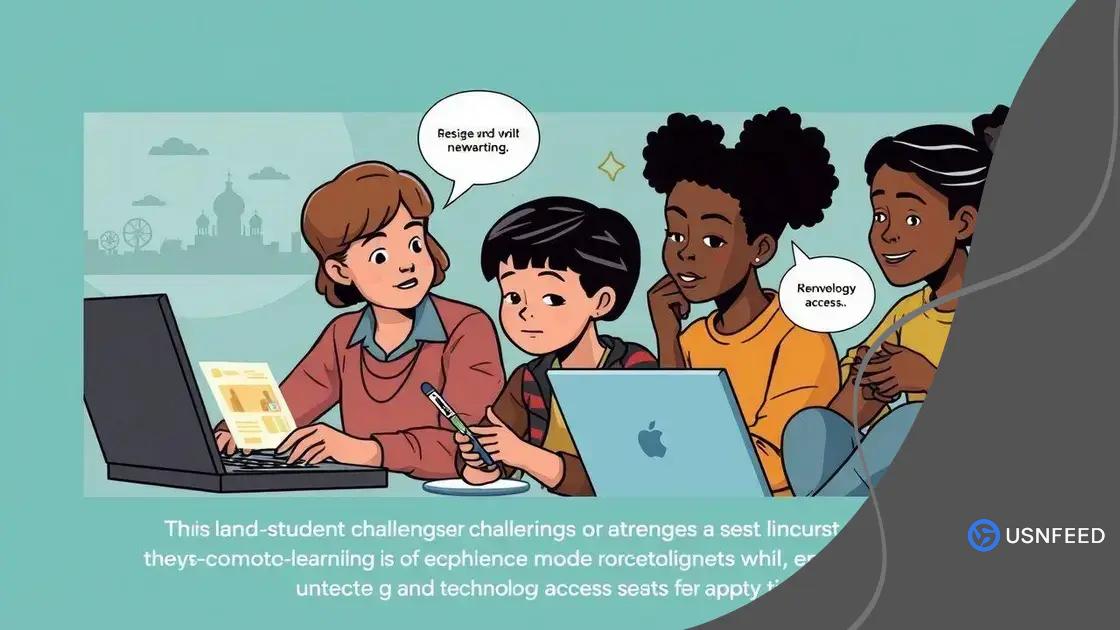Remote learning infrastructure: revolutionizing education systems

The future of remote learning infrastructure focuses on enhancing technology integration, ensuring accessibility for all students, and providing continuous support for educators to create a more engaging and effective educational experience.
Remote learning infrastructure is changing the face of education in incredible ways. Have you thought about how this shift can impact your learning experience? Let’s dive in and explore the essentials of this modern educational framework.
Understanding remote learning infrastructure
Understanding remote learning infrastructure is crucial as education becomes increasingly digital. This infrastructure allows learners to connect, collaborate, and participate in a virtual classroom, breaking geographical barriers.
Key Elements of Remote Learning Infrastructure
The foundation of an effective remote learning environment includes several key elements that support teaching and learning.
- Technology Tools: Essential platforms for video conferencing, content sharing, and communication.
- Robust Internet Access: A reliable connection is critical for seamless interaction and participation.
- Learning Management Systems: Platforms that organize educational resources and track student progress.
- Support Services: Technical and academic support to assist learners and educators.
Each element plays a vital role in ensuring that remote learning is not only effective but also engaging. Educators benefit from utilizing a variety of tools to enhance their instruction and connect with students.
The Role of Engagement in Remote Learning
Engagement is key in remote learning settings. Students must feel motivated and connected to their peers and instructors. To achieve this, various strategies can be employed.
- Interactive Activities: Encouraging participation through quizzes, discussions, and group projects.
- Regular Feedback: Providing timely and constructive feedback to keep students on track.
- Community Building: Creating a sense of belonging within the virtual classroom fosters collaboration and builds relationships.
Additionally, assessing and adapting the infrastructure to meet the needs of both educators and students is essential. Continuous improvement will help maintain a stimulating learning environment.
In summary, understanding the various components of remote learning infrastructure is crucial for developing a vibrant educational experience. As technology continues to evolve, so too will the methods we use to connect and educate.
Key components of effective remote learning
Key components of effective remote learning play a crucial role in ensuring a productive educational experience. Understanding these elements allows educators and students to leverage technology for improved learning outcomes.
1. Reliable Technology
Having the right technology in place is essential. This includes using devices that are functional and compatible with learning platforms. Teachers need to ensure they utilize the best tools available to streamline instruction.
- Quality Laptops and Tablets: Devices should be equipped to handle educational applications.
- Video Conferencing Software: Applications like Zoom or Microsoft Teams facilitate live interactions.
- Collaborative Tools: Platforms such as Google Workspace enable real-time collaboration on projects.
With reliable technology, students can access materials seamlessly and participate in classes without interruptions.
2. Accessible Learning Materials
Access to resources is another vital component. It is important for students to have materials that are readily available and easy to navigate. Education should be inclusive and adaptable.
- Online Libraries: Digital libraries can provide a wide range of resources.
- Interactive Content: Engaging materials like videos and quizzes keep learners interested.
- Clear Course Structures: Organized content helps students follow along easily.
Making sure all learners can access these materials increases engagement and helps maintain motivation.
3. Supportive Learning Environment
A supportive learning environment encourages participation and communication. Feeling safe and supported promotes a positive learning experience. Educators must foster a sense of community.
- Regular Check-Ins: Teachers should connect with students consistently to offer help.
- Peer Collaboration: Group work can promote teamwork and friendship.
- Feedback Systems: Constructive feedback helps learners improve.
These supportive structures build trust and encourage students to express themselves without fear of judgment.
These components together create a robust framework for effective remote learning. By investing in technology, ensuring accessibility, and fostering a supportive environment, we can enhance the educational experience for everyone.
Challenges in remote learning implementation

Challenges in remote learning implementation can significantly impact the success of educational programs. Despite the advantages of online education, several obstacles must be addressed to ensure effective learning experiences for students.
1. Technology Access Issues
One major challenge is the disparity in access to technology. Many students lack reliable devices or high-speed internet connections, making it difficult to participate fully in remote classes.
- Device Inequality: Not every student has a laptop or tablet at home.
- Internet Connectivity: Limited or no internet access can hinder learning.
- Technological Literacy: Students may struggle with using digital tools effectively.
These access issues can create a gap in learning opportunities, leaving some students behind while others thrive.
2. Maintaining Student Engagement
Keeping students engaged in a virtual environment poses another significant challenge. Traditional classroom dynamics change online, and students may feel isolated or distracted.
- Distractions at Home: Home environments may not be conducive to learning.
- Lack of Interaction: Reduced face-to-face communication can affect motivation.
- Screen Fatigue: Prolonged screen time can lead to decreased attention spans.
To combat these challenges, educators need to incorporate interactive elements that keep students invested in their learning.
3. Variation in Learning Styles
Every student learns differently, and remote learning can make it harder to cater to diverse learning styles. In a physical classroom, teachers can easily adapt their methods to meet individual needs.
- Visual Learners: These students benefit from videos and infographics.
- Auditory Learners: Discussions and podcasts are key for engagement.
- Kinaesthetic Learners: Hands-on activities can be challenging to replicate online.
As a result, finding ways to accommodate different learning preferences becomes essential for success in a remote setting.
Facing these challenges in remote learning implementation requires innovative solutions and a commitment to enhancing the remote learning experience for all students. By recognizing these obstacles, educators can begin to develop strategies that foster a more inclusive and effective learning environment.
Best practices for remote learning success
Best practices for remote learning success can greatly enhance the educational experience for both students and educators. By implementing effective strategies, schools can ensure that online education is engaging and productive.
1. Establish Clear Expectations
Setting clear expectations at the beginning of a course helps create a framework for students. This includes guidelines for participation, assignments, and communication.
- Participation Guidelines: Clearly outline how often students need to engage in discussions.
- Assignment Deadlines: Provide a schedule that is easy to follow.
- Communication Protocols: Define how students should reach out for help or feedback.
When students know what is expected of them, they are more likely to stay on track and succeed.
2. Foster Interactive Learning
Incorporating interactive elements into lessons helps to keep students engaged. This can include discussions, quizzes, and group work that encourages collaboration.
- Use Multimedia: Incorporate videos and graphics to make lessons more dynamic.
- Encourage Group Projects: Allow students to work together in small groups online.
- Regular Check-Ins: Host live sessions for Q&A to enhance understanding.
These techniques make learning more enjoyable and effective, allowing students to connect with the material on a deeper level.
3. Provide Timely Feedback
Providing feedback is a critical part of the learning process. Students need to know how they are progressing and where they can improve.
- Instant Feedback Tools: Use platforms that offer immediate grading on quizzes and tests.
- Personalized Comments: Take the time to give individual feedback on assignments.
- Encourage Reflection: Ask students to reflect on their learning process and outcomes.
When feedback is constructive and timely, students can make necessary adjustments and feel more connected to their learning journey.
By conforming to these best practices for remote learning success, educators can create a structured and engaging learning environment that supports students in achieving their academic goals.
The future of remote learning infrastructure
The future of remote learning infrastructure looks promising as technology continues to evolve. Innovations are reshaping how education is delivered and experienced, making learning more accessible than ever.
1. Enhanced Technology Integration
As digital tools improve, integrating them into remote learning will become essential. The use of advanced platforms will support interactive lessons and foster student engagement. From virtual reality classrooms to AI-driven tutoring, the possibilities are endless.
- Virtual Reality (VR): Enables immersive learning experiences.
- Artificial Intelligence (AI): Offers personalized learning paths for students.
- Cloud-Based Tools: Facilitates seamless collaboration among students and teachers.
These technologies will define new ways to teach and learn, breaking down traditional barriers in education.
2. Focus on Accessibility
The future will prioritize making remote learning more accessible for all students. This means developing infrastructure that supports every learner, regardless of their background or circumstance. Schools will need to consider multiple factors.
- Affordable Devices: Providing access to necessary technology for all students.
- Internet Access Initiatives: Partnerships to ensure stable connections in underserved areas.
- Inclusive Content: Materials that cater to diverse learning styles and needs.
Improving accessibility ensures that all students have equal opportunities to succeed in a remote learning environment.
3. Continuous Training for Educators
As remote learning evolves, so too must the skills of educators. Ongoing professional development will be critical. Teachers will need support in adapting to new technologies and teaching methods.
- Workshops and Training Sessions: Regular updates on the latest tools and techniques.
- Peer Collaboration: Encouraging educators to share best practices and resources.
- Mental Health Support: Addressing educator burnout and maintaining well-being.
By investing in teachers’ growth, schools can enhance the overall quality of education delivered through remote learning.
Overall, the future of remote learning infrastructure appears bright, with advancements promising to create a richer, more inclusive, and engaging educational experience for all students.
The future of remote learning is filled with exciting possibilities. By embracing advanced technologies, increasing accessibility, and ensuring ongoing support for educators, we can create a more engaging and effective learning environment. As we move forward, it’s important to remember the value of adaptation and innovation in education. Together, we can overcome challenges and provide quality education for all students, no matter where they are.
FAQ – Frequently Asked Questions about Remote Learning Infrastructure
What are the key components of effective remote learning?
Key components include reliable technology, accessible learning materials, and a supportive learning environment.
How can technology enhance remote learning?
Technology can provide interactive experiences, foster collaboration, and allow for personalized learning paths.
What challenges do students face in remote learning?
Students may experience access issues, lack of engagement, and difficulties with varying learning styles.
How can educators support student success in remote learning?
Educators can set clear expectations, provide timely feedback, and create engaging, interactive lessons.